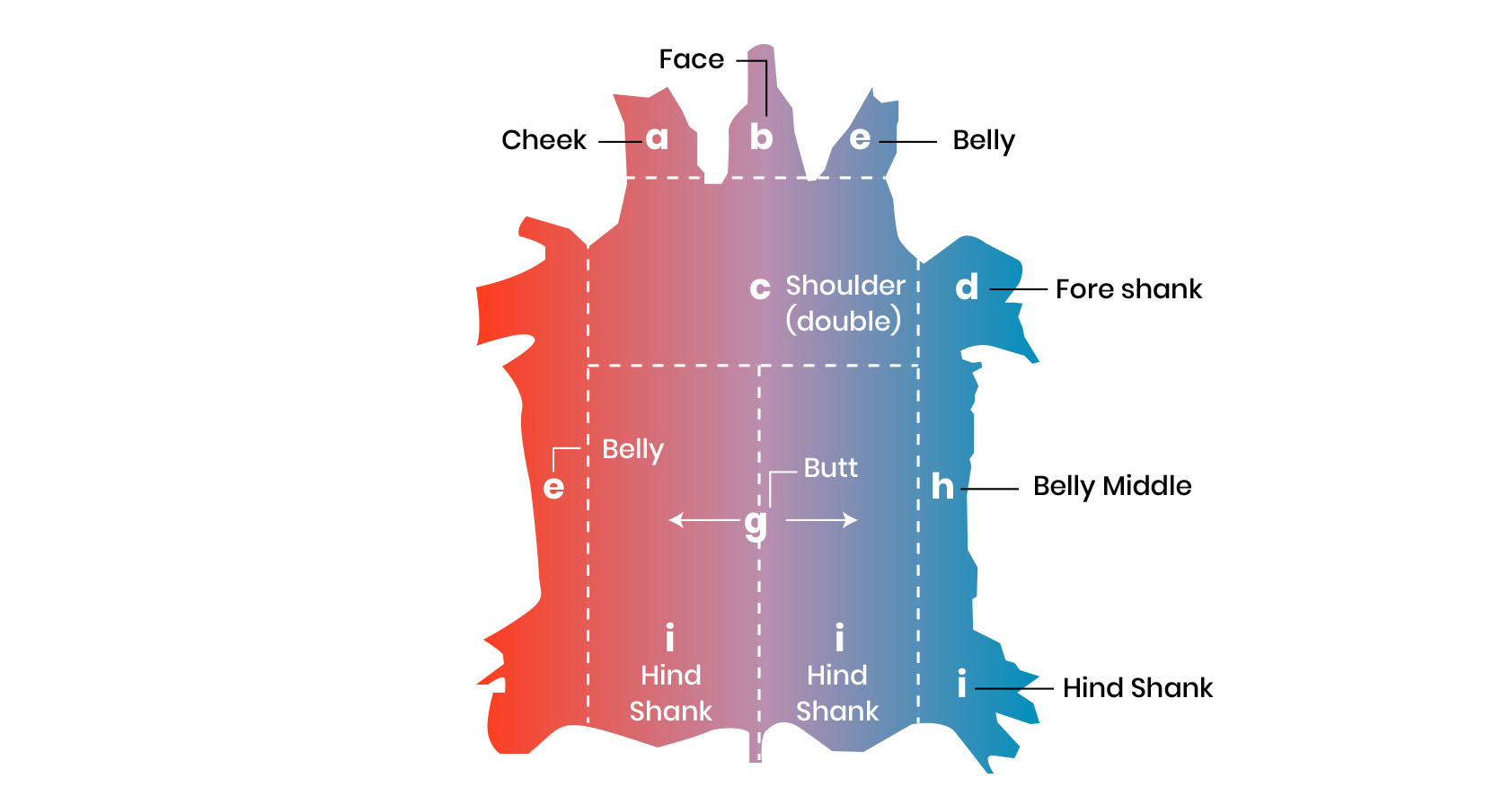Hide Types & Sizes
Types of leather
No other fabric can compare with the unique textures, rich colors, strength, or smell of real leather. This beautiful, traditional, ancient, natural, lasting and renewable material is in a category all its own with different sizes, weights, types, finishes and prices. The joy of working with real leather is all in the longevity of the finished projects, garments, and accessories that last well beyond the years of any other fabric or fiber.
Leather is a natural by-product. Modern leather manufacturing recycles over 270 million cow hides each year. These are a by-product of the food industry and without the ability of the leather industry to transform them into leather, over 7 million tonnes would go to landfill with huge environmental and biological impact. Leather makes a sustainable contribution to a society that needs to consume less, reuse more and a recycle everything.
Leather at end of life will biodegrade, depending on type in between 10 & 50 years. We see leather trims being creatively incorporated into wall coverings, shoes, clothes, plus more and more companies are recycling the leather component from footwear and leather goods into something new.
Hide Sizes, Sections
Hides come in a variety of shapes and sizes depending on the animal & country the hide originates from. The type of finishes and processes will also contribute to the overall cutting of the hides.
The following are diagrams and average sizes for various types.

Understanding Hide Finishes
ANILINE VRS SEMI-ANILINE: Aniline leather is colored by immersing hides in a dye bath with transparent, aniline dyes that fully penetrate the hide. Like our skin in the sun, the animals skin and take the dye colour differently. These leathers are the most natural and often the most pristine hides are used. All surface imperfections and flaws (or beauty marks) will be visible in aniline dyed leathers and is meant to be cut within the pces created.
Semi Aniline leathers are aniline dyed with an added layer of pigment or surface coating to enhance durability and color consistency. Imperfections and flaws are still visible, but colour consistency would be more equalized.
FULL GRAIN LEATHER VRS TOP GRAIN VRS SPLIT: Full Grain refers to leather that has not been altered by sanding or buffing. Full Grain leather retains the grain layer, original texture and markings that naturally occur during the lifetime of the animal.
Full Grain is often confused with Top Grain, but “Top Grain” leather simply comes from the uppermost portion of a hide – the term “Top Grain” is referring to the layer of the hide from which the leather originates.
Split leather refers to leather is split into layers and sold as two different products: Top Grain (refers to the top portion) and Split leather (refers to the bottom portion). From the Top Grain portion of a hide comes both Full Grain and Corrected Grain leathers.
CORRECTED GRAIN LEATHER: Corrected Grain is also Top Grain leather. Corrected Grain leather undergoes a light buffing process to better absorb dye and minimize the appearance of blemishes and natural leather markings on its surface. Corrected Grain leather is often preferred for use in projects where uniform color desired.
PIGMENTED LEATHER: An oil based coloration (Pigment) is applied superficially to the surface of leather, it provides colour consistency and maximum protection to the leather. Pigmented leathers are a top-grain leather which has been aniline dyed in the drum, and then extensively finished to conceal natural markings and protect the leather against extreme usage. Pigmented leathers are buffed to try and conceal natural markings like scratches and bug bites, finished with opaque pigments and protective top-coats and strongly embossed (sometimes called “corrected grain”) for enhanced durability, stain and fade resistance, natural markings will still be visible, as would brand marks.
VEGETABLE TANNING VS. CHROME TANNING: Vegetable Tanning is the oldest method of tanning. It utilizes vegetable tannins and extracts from trees and plants for use in the tanning process. Today, vegetable tanned leather is still utilized by boot and saddle makers. This process is a more costly endeavor.
Chrome Tanning, most of the world’s leather is tanned this way as it is a proven process that produces a stable end-product, accounting for approximately 90% of leather produced globally today. Chrome tanning uses the minerals of chromium salts to tan hides.
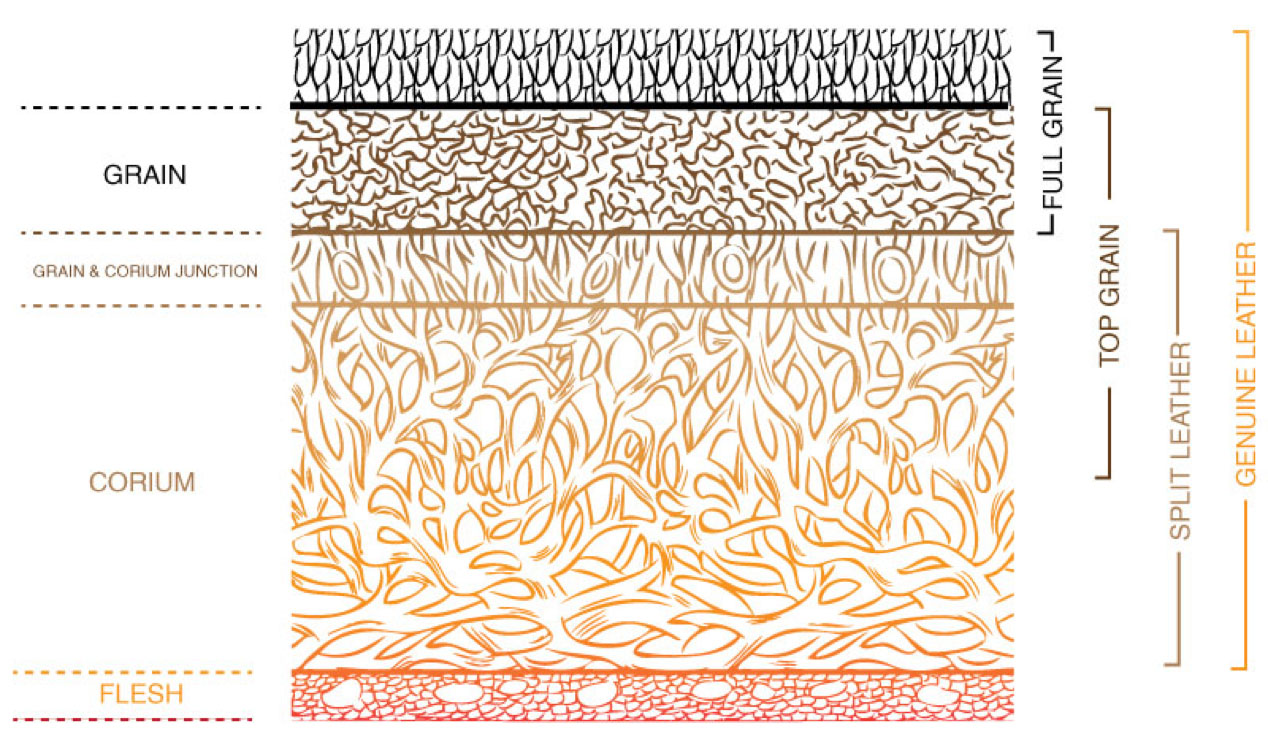
Leathers Natural Characteristics
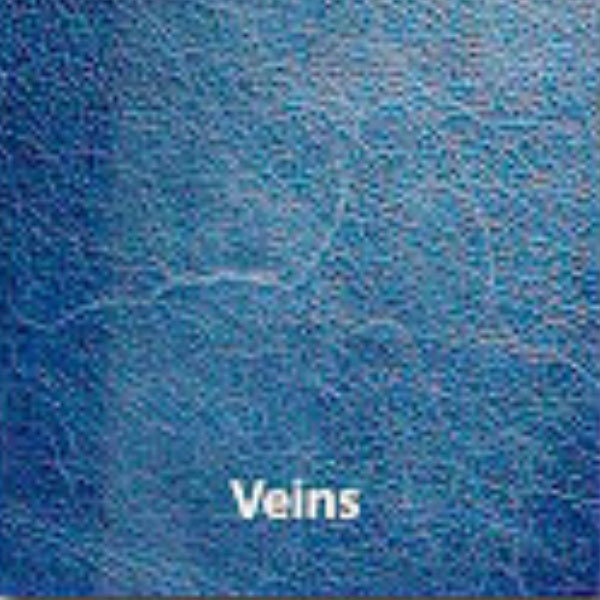
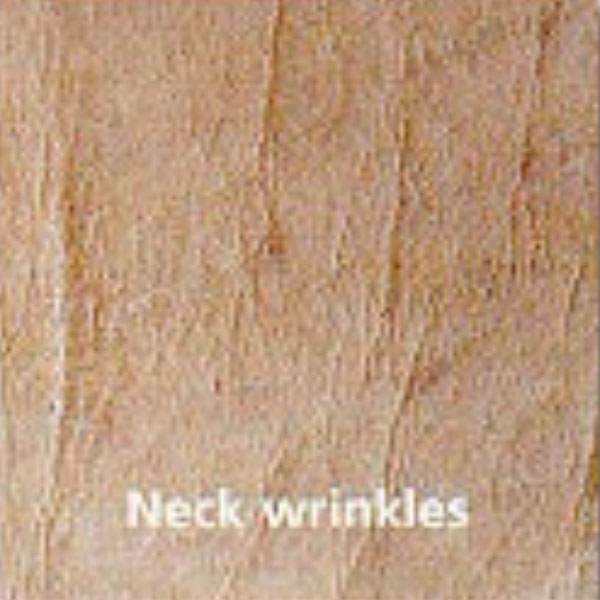
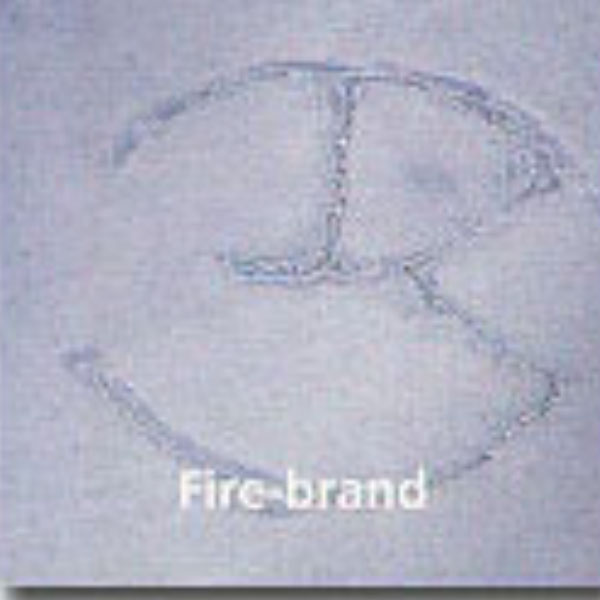
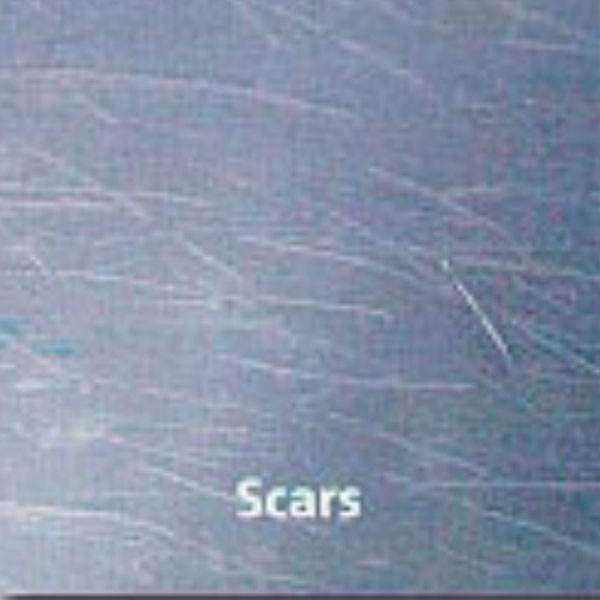
The life of a herd (cow) is eventful, which can also be a danger for the skin (leather) of the animal; let’s think about the brands as well as scratches caused by the barbed wire, wounds and abrasions…
The traces of these experiences left on the leather, are not defects but rather the proof that we are in front of a completely natural product, more defects shown, more natural the product.
Leather is a substance which keeps its properties unchanged for many, many years, but it must be looked after with care: it must be kept far from strong heat sources, sheltered from direct sunlight, and protected from water.
Surface Variations – European Cow
The below diagram illustrates the various surface variations that can occur in a cow hide:
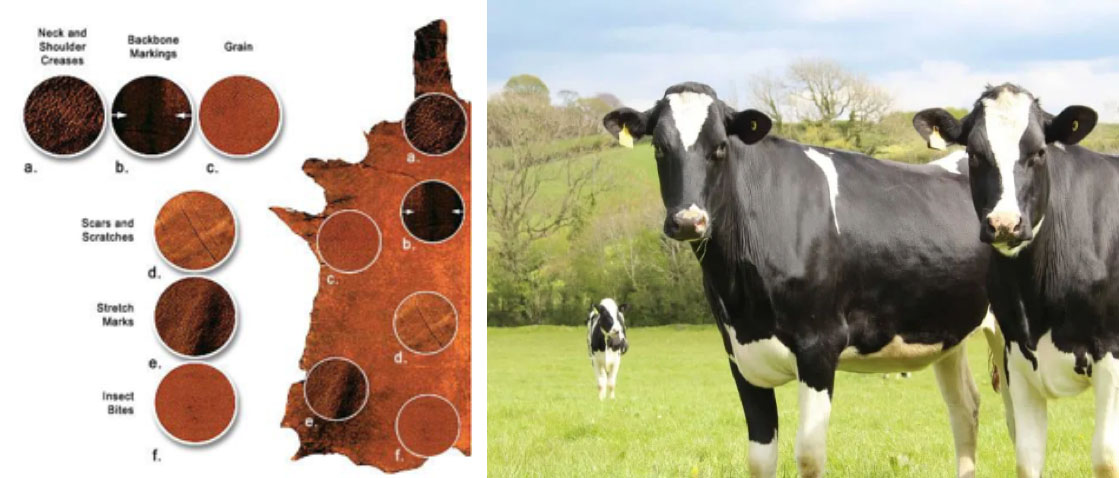
- Natural, subtle variations in color and grain, much like wood varies when stained, no covering up any natural markings, scars, scratches, wrinkles, stretch marks and other natural characteristics. These are unique characteristics and will be incorporated into upholstered furniture.
- The European Cow ranges free, no fences, barb wire effect, no branding within Europe.
- Back Bone, neck wrinkles, belly wrinkles, all very common for the European cow when process for an Aniline, Wax Pull Up.
- More natural leather are used for this particular cow.
Surface Variations – Brazilian Cow
The below diagram illustrates the various surface variations that can occur in a cow hide:
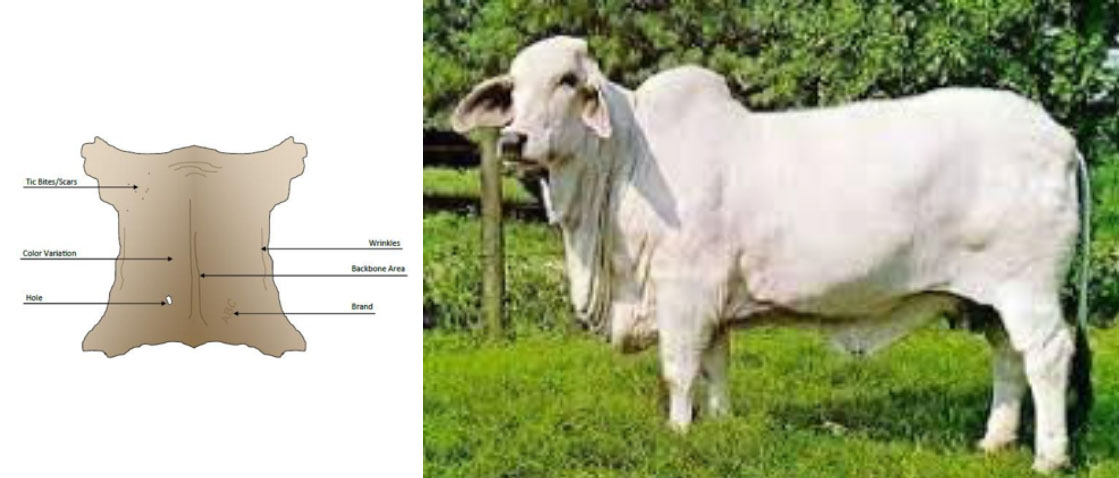
- Neck hole is common for Brazilian/SA Raw material, as this particular cow has a HUMP on his neck, consequently this is the structure of the cow. Sometimes these holes are sewn shut. Because the hides are very large from this area, this should not affect the yield when cutting.
- Scars and scratches in the butt could be caused by barbed wire fences, or other surfaces.
- Small tics or holes can be found around the top section (neck portion) depending on the certain climate/country material comes from. This could be caused by rash, bug bites, etc… Certain seasons this will improve or be magnified.
- Banded area (Butt), this is where the brands typically are, but it depends from what country the material comes from, there could be some central brands and can vary from 2-4 brands per hide, depending on material being purchased and how many times the cow is sold.
Below is a general categorization of the many types of leather
| Leather Type | Description | Tannage | Used for: |
|---|---|---|---|
| Bridle | Firm, rich-colored leather with just enough oils to withstand weather. Can be oiled for darker hues. | Vegetable | Belts, straps, fine pet collars, leashes, gun belts. |
| Chrome Oil Tanned | Beautiful, durable leather with the right amount of oil for a soft, supple feel. | Chrome | Chaps, cases & bags, boots. |
| Kipskin | Produced from smaller calf hides and generally very clean. Good for dye and stamping. | Vegetable Re-tanned | Belt liners, personal leather goods. |
| Latigo | A combination tanned leather designed to be rigid yet very pliable. Good for products in which strength and flexibility are needed. | Chrome Vegetable Re-tanned | Tack, straps, belts, pet collars, leashes, cinches. |
| Vegetable Tan Strap, Tooling & Molding | Leather for tooling, embossing, molding, dyeing & oiling. Uniformly absorbs dyes and oils. Dries to a firm, long-lasting shape. | Vegetable | Belts, straps, holsters & sheaths. |
| Shearlings & Sheepskins | Quality wool sheepskins in a variety of thicknesses. | Vegetable & Chrome tanned varieties | Lining saddles, padding, ect. |
| Suede | Leather finished by buffing the flesh side of the hide to produce a “nap”. | Chrome | Chaps, garments, trim. |
| Upholstery | Whole hides tanned for applications where large pieces of leather are required. Typically soft, supple, strong and durable. | Chrome | Upholstery, garments. |
For a cowhide, the below diagram illustrates the various sections the raw hide
Hide Area Descriptions
